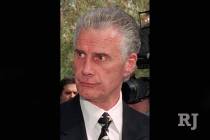Unveiling of museum logo renews debate on whether mob ran Las Vegas
Las Vegas was a better place when the mob ran the town. Now how many times have you heard that old saw?
There’s even a book out titled “When the Mob Ran Vegas” by Steve Fischer. Flipping through it, I noticed Fischer described mobster Herbie Blitzstein as 6 feet 6 inches tall. I talked to Herbie enough while he still walked this earth to know that wasn’t accurate.
Wednesday’s unveiling of the humorous logo for the new mob museum, expected to open in the old downtown post office in 2010, reignites the debate: Did the mob really run the town?
Leslie Niño Fidance, a student at the Boyd School of Law, took a bold move, one likely to be both cheered and jeered, in her research paper titled “The Mob Never Ran Vegas.” The emphasis was on “never.” Specifically, she argued the mob didn’t control local government and didn’t control gaming regulators, thus didn’t control the city.
For real insights, Fidance and I both turned to someone who should know — Las Vegas Mayor Oscar Goodman. As the lawyer for the late mobster Tony Spilotro and his pal Frank Rosenthal, Goodman always called himself a “need to know” attorney. If he didn’t need to know, he didn’t ask.
When I asked him recently if the mob really ran Las Vegas, particularly government, Goodman had to think about it, especially since he’s been on the inside of government since being elected mayor in 1999.
“I know the rumors that they had influence over some politicians,” he said cautiously, mentioning “Cleanface.” (Fidance, in what seemed like a gaping omission, didn’t address suspicions that Sen. Harry Reid, as Gaming Commission chairman, was under the thumb of mobsters who called him “Cleanface.” State authorities concluded after an investigation that the “Cleanface” references caught on surveillance tapes were unsubstantiated boasting by mobsters. The allegations didn’t hold Reid back from becoming Senate majority leader.)
Goodman said the mob didn’t run everything. “The mob probably tried to influence individual politicians for matters that were of interest to them, but as far as running government, I would say absolutely not.”
Goodman is no Pollyanna. He represented some of the mob guys talking about “Cleanface.” He knew there were corrupt politicians in Las Vegas. But he said they were corrupt “for their own self-interest,” not because they were doing the mob’s bidding.
Goodman’s comments to me dovetailed with what former Gaming Control Board member Jeff Silver told Fidance in her research to prove the mob never ran Las Vegas. “These guys wouldn’t want to run a city … there wasn’t any money to be made running a city.”
Nobody is saying the mob didn’t flourish, influence and shape Las Vegas, funding the purchase of casinos and then skimming from them to avoid paying taxes, loan sharking out of poker rooms and running illegal bookmaking operations. Nobody believes calls weren’t made between mobsters and elected officials, including law enforcement officials.
Fidance, who has lived in Las Vegas since she was 5, conceded it would be naive to deny that many Las Vegas gaming legends had connections to organized crime, such as Moe Dalitz. When she started her research, she thought she might be disproving the concept she was pursuing at the suggestion of her Gaming Law Policy Seminar teacher, gaming attorney Bob Faiss, who bristles at the suggestion the mob had some all-encompassing power.
Silver told her there was a clear turning point that set the “mob on the run.” It occurred in 1977 and naturally, there’s a Goodman connection — Rosenthal. That was the year the Nevada Supreme Court upheld the Nevada Gaming Commission’s denial of a key casino employee license for Rosenthal.
Fidance concluded, “The Rosenthal decision was yet another signal that the mob did not run Las Vegas. If the mob had run Vegas, Rosenthal could have received his key employee license without incident.”
If the mob ran Las Vegas, wouldn’t Goodman have succeeded in his bid to keep so many of his clients — Spilotro, Rosenthal and Nick Civella come to my mind — out of the Black Book, a list of people banned from casinos?
Goodman believes the myth of the mob’s tentacles is part of what makes the city unique and should be preserved and honored in the mob museum. But he was unwavering in his denial that the mob ever controlled local government.
He ought to know.
Unless, perhaps, he had no need to know.
Jane Ann Morrison’s column appears Monday, Thursday and Saturday. E-mail her at Jane@reviewjournal.com or call (702) 383-0275.












